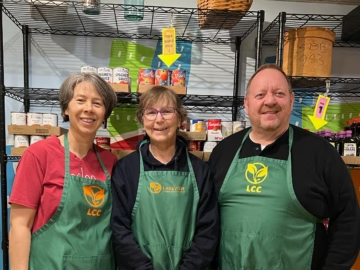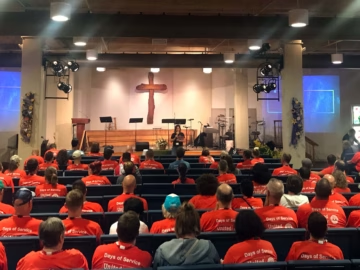
The colossal misunderstanding of our time is the assumption that insight will work with people who are unmotivated to change. Communication does not depend on syntax, or eloquence, or rhetoric, or articulation but on the emotional context in which the message is being heard. People can only hear you when they are moving toward you, and they are not likely to when your words are pursuing them. Even the choicest words lose their power when they are used to overpower. Attitudes are the real figures of speech.
Edwin H. Friedman
I love watching college basketball, and one of the great joys of fatherhood for me has been teaching my two youngest daughters to cheer for the North Carolina Tarheels.
So, you might imagine this was a fantastic year for us as we watched the ‘Heels defeat Gonzaga to win the NCAA National Championship … except that my daughters are also very empathetic people. So as I was jumping around excited for the victory, my girls were watching the Gonzaga players weep over the crushing blow that was dealt to them. And they felt bad. Worse, they made me feel bad for cheering!
And the more we distance ourselves from those who disagree with us, the more likely we are to demonize them and treat them as something other than human.
My wife chimed in, “They’re 18-year-old kids! How can you be happy to see them lose?”
But of course, you don’t see human beings when you’re a fan. You only see winners and losers.
Lately, many of us have become fans. We view the world in terms of winners and losers and all we care about is that our “team” wins. After all, the other side is the “opponent,” the enemy.
“They” might be people from a different political party or ethnic group or generation. Perhaps “they” are progressive Christians or conservative Evangelicals. Or maybe “they” are part of the LGBTQ community or supporters of traditional marriage.
Whatever they are, one thing is for sure, they are a “they.” They don’t have a family or hopes and dreams. They don’t have a nuanced position based on careful thought and passionate study. They don’t care about truth. They are a caricature of a person.
And the more we distance ourselves from those who disagree with us, the more likely we are to demonize them and treat them as something other than human.
The less human someone is, the easier it is to defeat them without a second thought to their well-being. In that way, objectifying the opposition is an effective strategy when your end game is defeating your enemy.
However, as a follower of Jesus, I should have a different end game. Rather than crushing our enemies, we’re called to love them. And one of the first steps toward loving anyone is seeing them as human, and the best way to do that is to listen to their story.
Rabbi Edwin Friedman says, “People can only hear you when they are moving toward you. … ”
I think this captures what Jesus is saying when he calls us to love our enemy. To love our enemy is to move toward him or her. To love our enemy is to cease from seeing them as a caricature, an ideology, and to, instead, see them as a human being — an image bearer of God.
How can we do this?
This thought has plagued me as a pastor. How do I help my affluent, suburban congregation learn to love people with whom they rarely interact but have strong opinions about? How do we help them “move toward” those they might otherwise see as an enemy?
Well, I don’t know the answer, but we’re going to try something.
Our first step was to reach out to communities our people rarely engage with and who, lately, have been stigmatized nationally and locally: a pastor from a Spanish-speaking church that serves a largely immigrant population, a Muslim business leader, a rabbi from a local synagogue, someone working to help undocumented immigrants attain legal status, and a representative from the local battered women and children’s shelter.
We started with lunch or coffee. We asked lots of questions. We listened to their stories.
As we did this, we moved toward these people — metaphorically AND literally. We heard about their struggles and grew a real sense of connection with them.
Along the way an idea emerged: What if our congregation had this same opportunity? What if they could sit down across from a Muslim, an immigrant, a Jewish man, a battered woman, and hear their stories and see them, not as a caricature, not as some distant “other,” but as an image-bearer of God not so different from them?
And so we are beginning a five-week experiment we’re calling “Neighbors.” The idea behind it is that you can’t love a neighbor you don’t know — a neighbor you’re moving away from. So let’s create space to move toward one another.
To do this we’re hosting some guests on Sunday mornings. We’re beginning with a “pulpit swap” where I will interview the Spanish-speaking pastor, and he’ll preach to our congregation (with an interpreter). Immediately after the service, we’ll drive downtown to his church (along with any of our people who want to join us), and I’ll preach (with an interpreter).
The next week we’ll welcome a representative from the local women’s shelter. The week after that, an individual working to establish an immigration office in the city. Then finally on the last Sunday, I will interview the founder of the local Islamic Prayer Center along with a local rabbi.
This is only the beginning, and to be honest, I have no idea how it will go. But my prayer is that as we choose to move toward our neighbors, we will finally be able to hear them, growing empathy and understanding, and learning what it really means to see the neighbor in ‘the other’ and to love our neighbor as ourselves.
Even if they rooted for Gonzaga.
Originally published for the spring 2017 issue of Shalom: A Journal for the Practice of Reconciliation.



